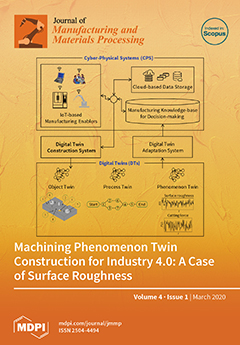The objective of this work was the development of a methodology to parametrize wire + arc additive manufacturing (WAAM), aiming dimension repeatability, and tolerances. Parametrization of WAAM is a difficult task, because multiple parameters are involved and parameters are inter-dependent on each other,
[...] Read more.
The objective of this work was the development of a methodology to parametrize wire + arc additive manufacturing (WAAM), aiming dimension repeatability, and tolerances. Parametrization of WAAM is a difficult task, because multiple parameters are involved and parameters are inter-dependent on each other, making overall process complex. An approach to study WAAM would be through operational maps. The choice of current (I
m) and travel speed (TS) for the desirable layer width (LW) determines a parametrization that leads to either more material or less material to be removed in post-operations, which is case study chosen for this work. The work development had four stages. First stage, named ‘mock design’, had the objective of visualizing the expected map and reduce further number of experiments. At the second stage, ‘pre-requisite for realistic operational map’, the objective was to determine the operating limits of TS and I
m with the chosen consumables and equipment. Within the ‘realistic operational map’ stage, a design for the experiments was applied to cover a parametric area (working envelope) already defined in the previous stage and long and tall walls were additively manufactured. Actual values of LW (external and effective layer width) were measured and an actual operating envelope was reached. According to the geometry-oriented case study, a surface waviness index (SW
index) was defined, determined, and overlapped in the envelope. It was observed that the walls with parameters near the travel speed limits presented higher SW
index. This operational map was further validated (fourth stage) by selecting a target LW and finding corresponding three parametric set (covering the whole range of operational map) to produce walls on which geometry characterization was carried out. After geometry characterization, obtained LW was compared with the target LW (the maximum values were very tied, with deviations from +0.3 to 0.5 mm), with a SW
index deviation at the order of 0.05. Both results evidence high reproductivity of the process, validating the proposed methodology to parametrize WAAM.
Full article





